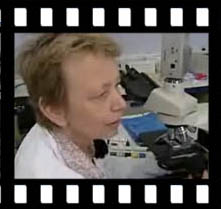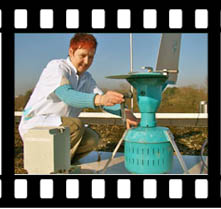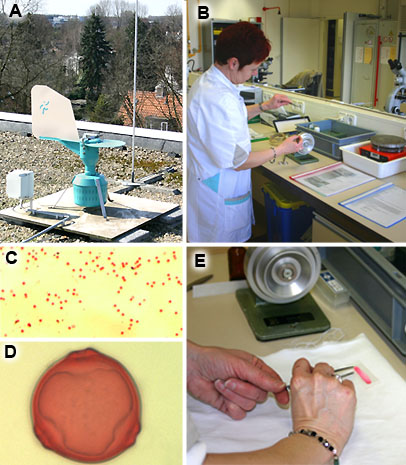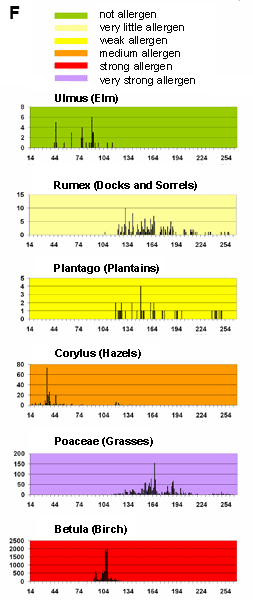Pollen counting |
|||||||||||||
Pollen which is dispersed by insects will not, or only rarely and locally, occur in the atmosphere. On the other side, pollen which is propagated by the wind has to be present in a high concentration in the air to have a reasonable chance for succesful pollination.
In the interest of people suffering of hay fever standardized countings of pollen are performed and published as tables, in the Netherlands and Belgium i.e. by the Elkerliek Hospital in Helmond (see movie about pollen counting in this hospital on the site of pollennieuws.nl) and the LUMC in Leiden, the University Hospital in Gent, the Belgian Scientific Institute for Health and the sites Natuurkalender. On account of pollen counting, knowledge on allergenicity of pollen species and the weather forecast hay fever prognoses can be made. In 1989 the "Aerobiology committee" of the EACCI (European Academy of Allergology and Clinical Immunology) and the EAN (European Allergy Network) work group of the IAA (International Association for Aerobiology) have decided to publish European pollen calenders in combination with complementary data. Only calenders made with a Burkard or Lanzoni spore trap over periods of 3 to 5 years are included. In 1999 the first European calenders with the name "The European Pollen Calendar" were published by the EAACI in collaboration with the "European Federation of Asthma and allergy associations" (EFA).
Method for pollen countingThe method forpollen counting has been standardized so that the data can always be compared everywhere. It consists of three steps:
1. Pollen collectionIn ordertocapture pollen so-called sporeor pollen traps are used. nearly everywhere the Burkard spore trap is prevailed (figure A). It consists of a horizontally free rotating chamber with a single opening that is oriented toward the wind by a wind vane. Above the opening a plate protects the entry from the rain, but also to obtain a regular air flow. Behind the opening a drum covered by a ribbon coated with vaseline. The drum with the ribbon makes a full turn in exactly a given time period of one day or one week. Below the chamber a centrifuge pump gently aspirates a standard volume of air per time unit trhrough the opening of of the chamber along the ribbon on the drum. The pollen grains stick to the ribbon.2. Microscopical samplesIn the laboratory the ribbon is released from the drum (figure B) and it is cut in egual parts. These are then transfered with the vaseline layer face down to a microscopical slide that has been prepared with a gel layer containing the stain safranin (Figure E). Mainly the walls of the pollen grains are stained light red (figure C). Then the strip can be covered with a coverslip for observation wiht a light microscope.3. Determination and counting of pollenWhen the sample is observed in the microscope at low magnification the single pollen grains become visible (figure C). But a high magnification (40x objective or higher) is necessary to distinguish the stained inner and outer wall. Then pollen grains can be identified and counted (figure D). These data can be used to calculate exactly how many pollen grains of which species/family have settled down on the ribbon at a given time point of the week. When compiled in a graph (fugure F) these data give an reliable indication for ther presence of certain pollen grains at a given time in the air. Such a graph is called pollen calendar. With help of a pollen calendar and weather forecast one can establish a forecast for allergenic pollen in the air. Simplified calendars also give already much information for hay fever patients (figure G).
Webpages and photographs:Jan Derksen and Elisabeth Pierson
|
|||||||||||||




